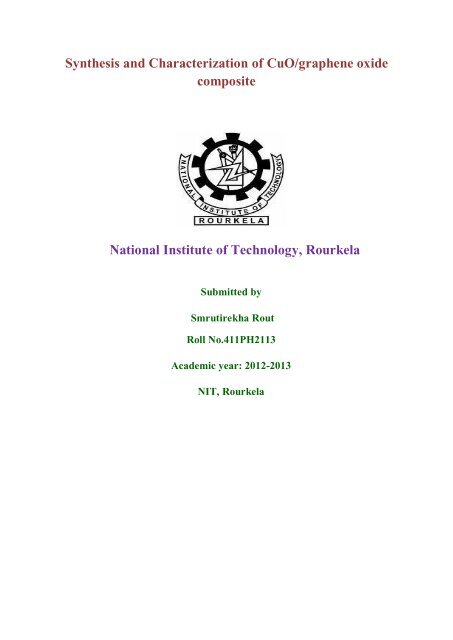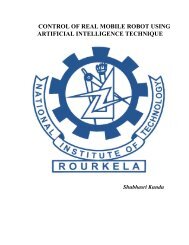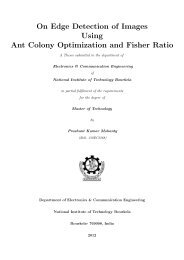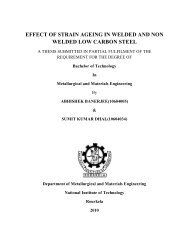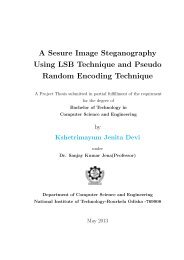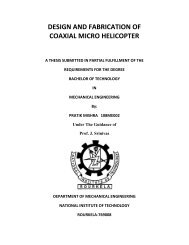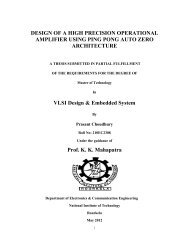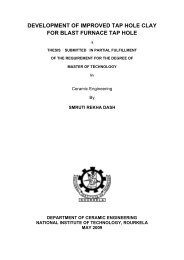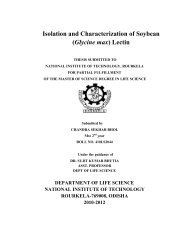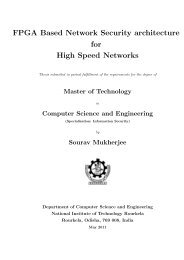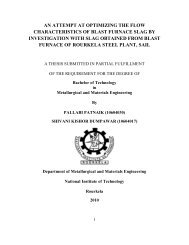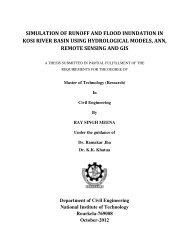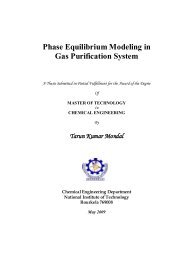Synthesis and Characterization of CuO/graphene oxide ... - ethesis
Synthesis and Characterization of CuO/graphene oxide ... - ethesis
Synthesis and Characterization of CuO/graphene oxide ... - ethesis
You also want an ePaper? Increase the reach of your titles
YUMPU automatically turns print PDFs into web optimized ePapers that Google loves.
<strong>Synthesis</strong> <strong>and</strong> <strong>Characterization</strong> <strong>of</strong> <strong>CuO</strong>/<strong>graphene</strong> <strong>oxide</strong><br />
composite<br />
National Institute <strong>of</strong> Technology, Rourkela<br />
Submitted by<br />
Smrutirekha Rout<br />
Roll No.411PH2113<br />
Academic year: 2012-2013<br />
NIT, Rourkela
CERTIFICATE<br />
This is to certify that the work in the report entitled “<strong>Synthesis</strong> <strong>and</strong> <strong>Characterization</strong><br />
<strong>of</strong> <strong>CuO</strong>/<strong>graphene</strong> <strong>oxide</strong> composite” by Smrutirekha Rout, in partial fulfilment <strong>of</strong> Master<br />
<strong>of</strong> Science degree in PHYSICS at the National Institute <strong>of</strong> Technology, Rourkela, is an<br />
authentic work carried out by her under my supervision <strong>and</strong> guidance. The work is<br />
satisfactory to the best <strong>of</strong> my knowledge.<br />
Supervised by<br />
Dr. P. Mahan<strong>and</strong>ia<br />
Assistant Pr<strong>of</strong>.<br />
Department <strong>of</strong> Physics<br />
National Institute <strong>of</strong> Technology, Rourkela
Declaration<br />
I hereby declare that the project work entitled “<strong>Synthesis</strong> <strong>and</strong><br />
characterization <strong>of</strong> <strong>CuO</strong>/<strong>graphene</strong> <strong>oxide</strong> composite” submitted to National<br />
Institute <strong>of</strong> Technology, Rourkela, is the record <strong>of</strong> an original work done by me<br />
under the guidance <strong>of</strong> Dr. Pitambar Mahan<strong>and</strong>ia Assistant pr<strong>of</strong>essor,Dept. <strong>of</strong><br />
Physics,NIT, Rourkela <strong>and</strong> this project work has not performed the basis for the<br />
award <strong>of</strong> any degree or diploma/associate-ship/fellowship <strong>and</strong> similar project if<br />
any.<br />
Smrutirekha Rout<br />
Roll No. - 411ph2113
ACKNOWLEDGEMENT<br />
I owe a debt <strong>of</strong> gratitude to Pr<strong>of</strong>. Sunil Kumar Sarangi, The Director, NIT, Rourkela for<br />
his vision <strong>and</strong> foresight <strong>of</strong> this One year Project which has immensely helped all <strong>of</strong> us to get a<br />
flavor <strong>and</strong> feel <strong>of</strong> research.<br />
I am most grateful to my Supervisor Dr. Pitambar Mahan<strong>and</strong>ia, for giving me the<br />
opportunity to work on an exciting project <strong>and</strong> for his for his inspiring guidance, constructive<br />
criticism <strong>and</strong> valuable suggestion throughoutthe project work. I wish to record my special<br />
thanks to Mr. Bamdev Das (M.Tech), Mr. Prakash Ch<strong>and</strong>ra Mahakul (Ph.D) <strong>and</strong><br />
KadambineeSa (Ph.D) for their valuable help in all respect <strong>of</strong> my project work. I would like<br />
to thank all the people who have contributed to this work.<br />
I record my sincere thanks to Department <strong>of</strong> Metallurgical <strong>and</strong> Material Science for<br />
extending all facilities to carry out the XRD <strong>and</strong> SEM.<br />
I express heartiest thanks to all the faculty members <strong>of</strong> Department <strong>of</strong> Physics, NIT<br />
Rourkela who have made direct or indirect contribution towards the completion <strong>of</strong> this<br />
project.<br />
It gives me an enormous pleasure to thank all my friends <strong>and</strong> all the research scholars<br />
<strong>of</strong> the Dept. <strong>of</strong> Physics. In particular, I would like to thank my parents for their unconditional<br />
love <strong>and</strong> patience.
CONTENTS<br />
Page No.<br />
Abstract 1<br />
Chapter -1<br />
1.1 Introduction 2-3<br />
1.2 Crystal Structure <strong>of</strong> <strong>CuO</strong> 3-4<br />
1.3 Graphene Oxide 4<br />
Chapter -2 Experimental Techniques<br />
2.1 Preparation <strong>of</strong> <strong>CuO</strong> 5<br />
2.2 Flow chart: <strong>Synthesis</strong> techniques for <strong>CuO</strong> 5<br />
2.3 Preparation <strong>of</strong> Graphene <strong>oxide</strong> 6<br />
2.4 Preparation <strong>of</strong> <strong>CuO</strong>/Graphene Oxide 6<br />
2.5 Flow chart: for <strong>CuO</strong>/<strong>graphene</strong> <strong>oxide</strong> composite 7<br />
2.6 <strong>Characterization</strong> techniques 8<br />
2.6.1 X-Ray Diffraction 8-9<br />
2.6.2 Scanning Electron Microscope 10<br />
2.6.3 UV-Visible Spectroscopy 10-11<br />
Chapter –3 Result <strong>and</strong> Discussion<br />
3.1 XRD Analysis 12-14<br />
3.2 SEM analysis 15-16<br />
3.3 UV-Visible Spectroscopy analysis 17<br />
Chapter-4 Conclusion <strong>and</strong> future work 18<br />
References 19-20
Abstract<br />
Copper <strong>oxide</strong> <strong>and</strong> <strong>graphene</strong> <strong>oxide</strong> composite have been prepared successfully.The<br />
prepared composite have been characterized by XRD,SEM <strong>and</strong> UV-Vis. B<strong>and</strong> gap<br />
calculation using formula E g =hʋ from UV-Vis shows a decrease in b<strong>and</strong> gap. The<br />
electrical transport is also expected to increase but yet to be analysed.<br />
1
CHAPTER-I<br />
1.1 Introduction<br />
Studies on copper <strong>oxide</strong> nanomaterial have grown substantially in recent years due to its<br />
direct b<strong>and</strong> gap<strong>and</strong> intrinsic p-type behaviour together with low cost fabrication <strong>and</strong> good<br />
electrochemical properties. Copper <strong>oxide</strong> shows two types <strong>of</strong> polymorphism, namely, cuprous<br />
<strong>oxide</strong> (Cu 2 O) <strong>and</strong> cupric <strong>oxide</strong> (<strong>CuO</strong>). These <strong>oxide</strong>s are the two most important stoichiometric<br />
compounds in the <strong>CuO</strong> system. Pure cupric <strong>oxide</strong> is a black solid with a density <strong>of</strong> 6.4 g/cm 3 . It<br />
also has a high melting point <strong>of</strong> 1330 ºC <strong>and</strong> is insoluble in water. <strong>CuO</strong> is intrinsic p-type<br />
semiconductors with relatively small b<strong>and</strong>gap (1.2-1.85 eV) <strong>and</strong> show many attractive properties<br />
that can be utilized in a diversity <strong>of</strong> applications.Copper <strong>oxide</strong>s are used for gas sensors for<br />
hydrogen[1] <strong>and</strong> volatile organic compounds[2] catalysis[3] <strong>and</strong> specially, cuprous <strong>oxide</strong> films<br />
were intensively researched in device applications such as photovoltaic solar cell [4]<br />
photoelectrochemical cell[5,6] <strong>and</strong> electrochromic coatings[7]. Based on its application <strong>and</strong><br />
interesting physical properties its synthesis has become important. Therefore, a wide range <strong>of</strong><br />
deposition techniques such as chemical vapor deposition[8] electrodeposition[9] thermal<br />
evaporation[10] sol-gel techniques[11] spray pyrolysis[12]pulsed laser deposition[13] <strong>and</strong><br />
plasma based ion implantation <strong>and</strong> deposition[14] have been used to prepare Cu <strong>oxide</strong>. The<br />
physical <strong>and</strong> chemical properties <strong>of</strong> <strong>CuO</strong> are affected by the deposition method <strong>and</strong> its<br />
conditions. Inaddition, it can also be influenced on the electrical properties.Cupric <strong>oxide</strong><br />
prepared by different methods also shows large variations in electrical properties <strong>and</strong> is shown in<br />
the table [15-19]<br />
2
Table No- 1.1 Electrical Properties <strong>of</strong> <strong>CuO</strong><br />
Another class <strong>of</strong> non metal <strong>oxide</strong> is the <strong>graphene</strong> <strong>oxide</strong>(GO). GO consists <strong>of</strong> oxidized<br />
<strong>graphene</strong> sheets (or ‘<strong>graphene</strong> <strong>oxide</strong> sheets’) having their basal planes decorated mostly with<br />
ep<strong>oxide</strong> <strong>and</strong> hydroxyl groups, in addition to carbonyl <strong>and</strong> carboxyl groups located presumably at<br />
the edges. Generally, GO is electrically insulating [20,21].The aim <strong>of</strong> this project is to prepare<br />
<strong>and</strong> characterize <strong>CuO</strong> <strong>and</strong> GO composite. It is evident that the <strong>CuO</strong> is p-type semiconductor.<br />
If it acts as an oxygen reducing agent, the oxygen could be extracted from GO <strong>and</strong> the<br />
<strong>CuO</strong> could be converted into n-type semiconductor or any other structure. The <strong>CuO</strong> <strong>and</strong> GO was<br />
prepared by solution methods.<br />
1.2 Crystal Structure <strong>of</strong> <strong>CuO</strong>:<br />
Copper (II) <strong>oxide</strong> belongs to the monoclinic crystal system. The space group <strong>of</strong> its unit<br />
cell is C2/c, <strong>and</strong> its lattice parameters are a = 4.6837A 0 , b = 3.4226A 0 , c = 5.1288A 0 , α = 90°, β =<br />
99.54°, γ = 90°. In the crystal the copper atom is coordinated by 4 oxygen atoms in an<br />
approximately square planar configuration.<br />
3
Figure 1 The Unit Cell <strong>of</strong> Copper (II) Oxide<br />
1.3 Graphene Oxide:<br />
Graphene has been attracting attention in recent years due to its potential for use in<br />
nanoscale devices. Graphene is a monolayer thick single sheet <strong>of</strong> graphite. The <strong>graphene</strong> sheet is<br />
the two-dimensional building block <strong>of</strong> carbon structures <strong>of</strong> all dimensions such as threedimensional<br />
graphite, the onedimensional carbon nanotube, <strong>and</strong> the zero-dimensional buckyball.<br />
Graphene <strong>oxide</strong> (GO) is a new carbon - based nanoscale material that provides an<br />
alternative path to <strong>graphene</strong>. It is a single atomic layered material made <strong>of</strong> oxidizing graphite<br />
crystals which available in large quantities at inexpensive prices. Structurally the Graphene <strong>oxide</strong><br />
is similar to a <strong>graphene</strong> sheet with its base having Oxygen-containing groups. These groups<br />
have a high affinity to water molecules. GO hydrophilic in nature <strong>and</strong> can be easily dissolved in<br />
water <strong>and</strong> other solvents allows it to be uniformly deposited onto wide ranging substrates in the<br />
form <strong>of</strong> thin films or networks. The basal planes <strong>and</strong> edges <strong>of</strong> the <strong>graphene</strong> <strong>oxide</strong> are<br />
functionalizing with hydroxyl, epoxy group <strong>and</strong> carbonyl groups which are attached at the edge.<br />
Then oxygen containing functional groups disturb the aromatic regions in the basal plane, so that<br />
the layer <strong>of</strong> GO consists <strong>of</strong> both aromatic regions <strong>and</strong> oxidized aliphatic six-membered rings,<br />
which leads to distorted SP 3 - hybridized geometry <strong>and</strong> results in the insulating property <strong>of</strong> GO.<br />
Graphene <strong>oxide</strong> is a poor conductor but when it treatment with heat, light or chemical reduction<br />
most <strong>of</strong> <strong>graphene</strong>'s properties are restored.<br />
4
CHAPTER-II<br />
2.1Preparation <strong>of</strong> <strong>CuO</strong>:<br />
5 ml <strong>of</strong> the above two (Cu (NO 3 ) 2 ⋅ 3H 2 O <strong>and</strong> citric acid) prepared solution <strong>and</strong> 50 ml <strong>of</strong><br />
<strong>graphene</strong> <strong>oxide</strong> (dispersed in water) was taken in another beaker, <strong>and</strong> it was stirred about 1 hour,<br />
keeping the temperature <strong>of</strong> the material at 100 0 C during the process. Then the composite was<br />
annealed at 200 0 C for 2 hour.<br />
2.2 Flow chart: <strong>Synthesis</strong> techniques for <strong>CuO</strong><br />
0.1 molar solution <strong>of</strong><br />
Cu (NO 3 ) 2 .3H 2 O in 100<br />
ml distilled water<br />
0.1 molar solution <strong>of</strong><br />
citric acid in 100 ml <strong>of</strong><br />
distilled water<br />
Mixture <strong>of</strong> the<br />
two solutions<br />
Gel formed<br />
At 100 0 c, constant stirring for 1 hr<br />
At 200 0 c<br />
A light fluffy mass<br />
<strong>of</strong> <strong>CuO</strong> formed<br />
Annealing at different<br />
temperature for 2 hour<br />
Black Powder<br />
5
2.3 Preparation <strong>of</strong> Graphene Oxide (GO)<br />
Similarly Go was prepared by solution method. GO is prepared firstprepared by modified<br />
Hummers’ method [22,23]. In brief, GO <strong>oxide</strong> sheets were prepared from exp<strong>and</strong>ed graphite<br />
flakes. To exfoliate the pre-oxidized graphite powders into few layer GO sheets, the exp<strong>and</strong>ed<br />
graphite (EG) powder (2 g) <strong>and</strong> 15.0 g KMnO 4 was added into H 2 SO 4 (120 ml) under ice-bath<br />
cooling <strong>and</strong> stirred for 2 h. The solution was diluted in DI water (250 ml), then 20 mL H 2 O 2<br />
(30%) added to it at room temperature. After precipitation for 12 h, the upper supernatant was<br />
collected <strong>and</strong> centrifuged, where the GO powders were obtained as precipitates. To remove the<br />
metal (MN 2+ )ions existing in the GO powders, they were dissolved in HCl solution. Finally, GO<br />
was washed many times with DI water till it reaches the PH-7.<br />
2.4 Preparation <strong>of</strong> <strong>CuO</strong>/GO composite<br />
5 ml <strong>of</strong> the above two (Cu (NO3)2 ⋅ 3H2O <strong>and</strong> citric acid) prepared solution <strong>and</strong> 50 ml<br />
<strong>of</strong> <strong>graphene</strong> <strong>oxide</strong> (dispersed in water) was taken in another beaker, <strong>and</strong> it was stirred about 1<br />
hour, keeping the temperature <strong>of</strong> the material at 1000C during the process. Then the composite<br />
was annealed at 2000C for 2 hour. The above process was repeated for <strong>CuO</strong> (10 ml)/ Graphene<br />
Oxide (50 ml).<br />
6
2.5 Flow chart: for <strong>CuO</strong>/<strong>graphene</strong> <strong>oxide</strong> composite:<br />
7
2.6 <strong>Characterization</strong> techniques:<br />
There are various techniques used for characterization characterizing different nanoparticles.<br />
Here we used the basic principles <strong>of</strong> few techniques that is used in the experimental part <strong>of</strong> this<br />
project work. These are X-ray diffraction (XRD), Scanning electron microscope (SEM) <strong>and</strong><br />
Absorption spectrophotometer (UV-VIS).<br />
2.6.1 X-Ray Diffraction:<br />
X-ray diffraction (XRD) is a versatile, non-destructive analytical technique which<br />
provides the information regarding the crystal structure <strong>of</strong> a substance. It gives us detail<br />
information about the lattice parameter, lattice defects, lattice strain, chemical composition,<br />
crystallite size (in case <strong>of</strong> nano particles) <strong>and</strong> the type <strong>of</strong> molecular bond <strong>of</strong> crystalline phase.<br />
The working principle <strong>of</strong> the XRD technique is simple in which a monochromatic characteristic<br />
x-rays produced by the impact <strong>of</strong> accelerated electrons with heavy metal such as Cu <strong>and</strong> which<br />
then gets filtered <strong>and</strong> collimated by nickel filters. If this x-rays beam with a characteristic<br />
wavelength λ strikes the solid with an incident angle θ then the scattered radiation is determined<br />
byBragg’s law.<br />
The x-ray diffractometer works on the principle <strong>of</strong> Bragg’s law. The general relationship<br />
between the wavelength <strong>of</strong> the incident X-rays, angle <strong>of</strong> incidence <strong>and</strong> spacing between the<br />
crystal lattice planes <strong>of</strong> atoms is known as Bragg's Law <strong>and</strong> expressed as:<br />
nλ = 2dsinθ<br />
Where, λ = wavelength <strong>of</strong> the incident X-rays in angstroms ((1.54 Å for copper)<br />
d = interplanar spacing <strong>of</strong> the crystal in angstroms<br />
θ = angle between the incident rays <strong>and</strong> surface <strong>of</strong> the crystal in degrees<br />
n = an integer 1, 2, 3….. (Usually equal 1)<br />
8
Fig 2 X-ray diffraction in accordance with Bragg’s Law<br />
The details <strong>of</strong> the XRD equipment are given below:<br />
Equipment name<br />
PHILIPS PW 1830 HT X-Ray Generator<br />
Target used<br />
Copper(Cu Kα)<br />
Scan rate<br />
3 0 per minute<br />
Wavelength <strong>of</strong> X-ray 1.54 A 0<br />
9
2.6.2 Scanning Electron Microscope:<br />
A scanning electron microscope (SEM) is a type <strong>of</strong> electron microscope that images a<br />
sample by scanning it with a high-energy beam <strong>of</strong> electrons in raster scan (step by step by the<br />
sequential scanning <strong>of</strong> the sample with the electron probe). It gives information about the<br />
sample's surface topography, morphology (crystalline structure), chemical composition, <strong>and</strong><br />
other properties such as electrical conductivity.The SEM has a large depth <strong>of</strong> field which allows<br />
a large amount <strong>of</strong> the sample to be focus at one time <strong>and</strong> produces an image that is a good<br />
representation <strong>of</strong> the three-dimensional sample.<br />
The Principle <strong>of</strong> SEM is an electron microscope uses an electron beam (e-beam) to produce a<br />
magnified (30,000 times magnify size) image <strong>of</strong> the sample. The important parts <strong>of</strong> a scanning<br />
electron microscope are an electron gun, a lens system, <strong>and</strong> an electron detector. The electron<br />
energy is typically 10 – 30 keV for most samples but for insulating samples the energy can be as<br />
low as several hundred eV. In SEM the working distance (distance from final lens <strong>of</strong> the micro<br />
scope to the surface <strong>of</strong> the specimen) varies from 5-40 mm. In SEM long working distances give<br />
good depth <strong>of</strong> focus <strong>and</strong> short working distances give poor depth <strong>of</strong> focus. A conventional SEMs<br />
with a magnification range <strong>of</strong> 20X-30000X with spatial resolution <strong>of</strong> 50 to 100 nm.<br />
The details <strong>of</strong> the SEM equipment are given below:<br />
Equipment name<br />
JEOL JSM-6480LV<br />
Magnification<br />
2000,….15000<br />
2.6.3 UV-Visible Spectroscopy:<br />
Ultra violet <strong>and</strong> visible radiation comprise only a small part <strong>of</strong> the electromagnetic<br />
spectrum which includes other forms <strong>of</strong> radiation like radio, NMR, infrared (IR), cosmic, <strong>and</strong> X<br />
rays etc. When radiation interacts with matter a number <strong>of</strong> processes can occur including<br />
reflection, scattering, absorbance, fluorescence/phosphorescence, <strong>and</strong> photochemical reaction. In<br />
general, when measuring UV-visible (UV-VIS) spectra, we want only absorbance to occur. Light<br />
10
is a form <strong>of</strong> energy, absorption <strong>of</strong> light by matter causes the energy content <strong>of</strong> the molecules or<br />
atoms to increase. When light passes through a sample the amount <strong>of</strong> light absorbed is the<br />
difference between the incident radiation (Io) <strong>and</strong> the transmitted radiation (I).<br />
The amount <strong>of</strong> light absorbed is expressed as:<br />
A = -log T<br />
Or, A = εcb<br />
Where, b=sample path length in cm<br />
c=concentration in mol/ lit<br />
ε =molar extinction coefficient in mol-1cm-1<br />
UV-VIS spectroscopy is a non-destructive technique <strong>and</strong> a small amount <strong>of</strong> sample is required<br />
for characterize it. This technique is useful to characterize absorption, transmission, <strong>and</strong><br />
reflectivity <strong>of</strong> different types <strong>of</strong> compounds <strong>and</strong> provides us information on the electronic<br />
bonding in a molecule.<br />
11
110<br />
112<br />
020<br />
004<br />
311<br />
202<br />
113<br />
220<br />
022<br />
Intensity(a.u)<br />
2O2<br />
111<br />
111<br />
3.1 XRD Analysis:<br />
CHAPTER- III<br />
Result <strong>and</strong> Discussion<br />
<strong>CuO</strong> without annealing<br />
<strong>CuO</strong> annealed at 500 0 c<br />
<strong>CuO</strong> annealed at 800 0 c<br />
20 30 40 50 60 70 80<br />
Position(2)<br />
Figure 3 XRD spectra <strong>of</strong> <strong>CuO</strong> nanoparticles without annealing<br />
<strong>and</strong> annealed at 500 0 C, 800 0 C.<br />
The typical XRD patterns <strong>of</strong> <strong>CuO</strong> nanoparticles annealed at different temperatures <strong>and</strong><br />
their composites with <strong>graphene</strong> <strong>oxide</strong> are shown in the figure no. (3) <strong>and</strong> (4). The phase <strong>of</strong> <strong>CuO</strong><br />
nanoparticles without annealing was perfectly matched with the International Centre for<br />
Diffraction Data (ICDD) card No 80-1268.From the XRD peaks, it was concluded that the <strong>CuO</strong><br />
nanoparticles is crystalline in nature. The <strong>CuO</strong> nanoparticles exhibited monoclinic structure<br />
having lattice constant a=4.6833A o , b=3.4208A o <strong>and</strong> c= 5.1294A o .<br />
In order to investigate the effect <strong>of</strong> temperature on <strong>CuO</strong> nanoparticles, material were<br />
further annealed at 500 0 C <strong>and</strong> 800 0 C. From the XRD peaks <strong>of</strong> <strong>CuO</strong> nanoparticles annealed at<br />
500 0 C <strong>and</strong> 800 0 C, it is clearly shown that the intensity <strong>of</strong> peaks increases with the increase in<br />
annealing temperaturewhich indicates that the crystallinity <strong>of</strong> <strong>CuO</strong> nanoparticles increases with<br />
12
Intensity(A.U.)<br />
Intensity(A.U)<br />
the increase <strong>of</strong> annealing temperature. Simultaneously, the peaks become narrower with the<br />
increase in annealing temperature resulting in the increase <strong>of</strong> crystallite size. The crystallite size<br />
was found to be 26.865nm <strong>and</strong> 35.2963nm for 500 0 C <strong>and</strong> 800 0 C respectively.<br />
2000<br />
8000<br />
7000<br />
1500<br />
6000<br />
5000<br />
1000<br />
4000<br />
3000<br />
500<br />
2000<br />
1000<br />
0<br />
0<br />
10 20 30 40 50 60<br />
2<br />
-1000<br />
10 20 30 40 50 60<br />
2<br />
13
Intensity(a.u)<br />
110<br />
202<br />
113<br />
111<br />
111<br />
Figure[(4), (5), (6), (7), (8), (9)] SEM image <strong>of</strong> graphite, exfoliated GO, XRD<br />
Pattern <strong>of</strong> graphite, exfoliated GO, <strong>and</strong> TEM image <strong>of</strong> GO respectively.<br />
The SEM image <strong>of</strong> typical graphite is shown in figure. From SEM image it is clear<br />
that how the sheets are stalked together. Figure shows the SEM image <strong>of</strong> exfoliated GO. It<br />
clearly shows that how the sheets are exfoliated <strong>and</strong> has been also confirmed by TEM .The XRD<br />
image <strong>of</strong> graphite is shown in figure. The graphitic peak (002-c axis) appears at 26.4 for graphite<br />
<strong>and</strong> other small peaks the hexagonal plane in <strong>graphene</strong> sheets. XRD <strong>of</strong> exfoliated GO is shown<br />
in figure. The XRD pr<strong>of</strong>ile is almost flat except a small peak about 11 o . This indicates that the<br />
GO is exfoliated <strong>and</strong> the small peak at 11 o is due to over stalked few layers GO with more than<br />
the interlayer distance (0.335 A o ).From TEM image it is clear that the GO is exfoliated.<br />
Graphene Oxide + <strong>CuO</strong> (5ml)<br />
Graphene Oxide +<strong>CuO</strong>(10ml)<br />
20 30 40 50 60 70<br />
Position(2)<br />
Figure 4 XRD <strong>of</strong> Graphine <strong>oxide</strong> (50 ml) /<strong>CuO</strong> (5ml) <strong>and</strong><br />
Graphine <strong>oxide</strong> (50 ml) /<strong>CuO</strong> (10ml) annealed at 200 0 C<br />
In XRD figure <strong>of</strong> <strong>CuO</strong> + Graphene Oxide composites the crystallite size <strong>of</strong> Graphene<br />
Oxide + <strong>CuO</strong> (5ml) are found to be more than Graphene Oxide/<strong>CuO</strong> (10ml) annealed at 200 0 C.<br />
The crystallite size was found to be 50.567nm <strong>and</strong> 41.7374 nm for Graphene Oxide + <strong>CuO</strong> (5ml)<br />
<strong>and</strong> Graphene Oxide + <strong>CuO</strong> (10ml) respectively.<br />
14
3.2 SEM analysis:<br />
Figure 11 SEM Images <strong>of</strong> <strong>CuO</strong> nanoparticles (a), (d) without<br />
annealed (b), (e) annealed at 500 0 C (c), (f) annealed at 800 0 C<br />
having resolution 5000x <strong>and</strong> 7000x respectively.<br />
Figure 11 shows SEM images <strong>of</strong> <strong>CuO</strong> nanoparticles at different temperature having<br />
different resolution. The SEM images [fig 11 (a), (d)] are the images <strong>of</strong> <strong>CuO</strong> nanoparticles<br />
without annealed having resolution 5000 x <strong>and</strong> 7000 x respectively. From the images, it is<br />
clearly seen that the particles are spherical in shape. The surface is not smoother. But the<br />
particle size lies well within nano range. Hence it confirms that the particles are in nano scale.<br />
From the SEM images <strong>of</strong> <strong>CuO</strong> nanoparticles, annealed at 500 0 C [fig 11. (b), (e)], it is<br />
clearly seen that the particles are getting agglomerated <strong>and</strong> thus there is an increase in particle<br />
size. The surface <strong>of</strong> <strong>CuO</strong> nanoparticles becomes smooth. Hence there may chance to get good<br />
electrical properties.<br />
As the <strong>CuO</strong> nanoparticles annealed at 8000C, the particles are agglomerated more. This<br />
agglomeration happens due to atomic diffusion. This diffusion happens due to heat treatment on<br />
15
the sample. As a result the electrical properties are expected to increase than that <strong>of</strong> without<br />
annealing <strong>CuO</strong> nanoparticles.<br />
Figure 12:-SEM Images <strong>of</strong> <strong>CuO</strong>/Graphene <strong>oxide</strong> composites annealed<br />
at 200 0 C for 2 hours at two different <strong>CuO</strong>/ <strong>graphene</strong> <strong>oxide</strong> concentration<br />
i.e. 5ml <strong>of</strong> <strong>CuO</strong> solution <strong>and</strong> 10 ml <strong>CuO</strong> solution with 50 ml grapheme<br />
<strong>oxide</strong> solution which dispersed in water<br />
Fig 12[(g), (h), (i), (j)] show the SEM images <strong>of</strong> <strong>CuO</strong>/Graphene Oxide compositehaving<br />
two different concentration i.e. 5 ml & 10 ml <strong>of</strong> <strong>CuO</strong> with 50 ml <strong>of</strong> <strong>graphene</strong> <strong>oxide</strong> with two<br />
different resolution 5000 x & 7000 x. From fig 12[(g), (h)], it is clearthat the <strong>CuO</strong> is covering on<br />
the basal plane <strong>of</strong> the GO <strong>and</strong> hence the agglomeration is avoided. Where for the composite<br />
prepared taking 10 ml <strong>of</strong> <strong>CuO</strong> with 50 ml <strong>of</strong> <strong>graphene</strong> <strong>oxide</strong> shows the agglomeration <strong>of</strong> <strong>CuO</strong>.<br />
This may be due to higher concentration <strong>of</strong> <strong>CuO</strong>.<br />
16
3.3 UV-Visible Spectroscopy analysis:<br />
Fig 13[(a), (b)] UV-VIS Spectra <strong>of</strong> <strong>CuO</strong> nanoparticles without annealed,<br />
annealed at 500 0 C & at 800 0 C <strong>and</strong> <strong>CuO</strong>/Graphene Oxide composites at<br />
two different <strong>CuO</strong>/Graphene Oxide ratio i.e. 5ml, 10ml <strong>of</strong> <strong>CuO</strong> with<br />
50 ml <strong>of</strong> <strong>graphene</strong> <strong>oxide</strong>.<br />
The optical properties <strong>of</strong> <strong>CuO</strong> nanoparticles have been studied by the UV-VIS Spectrum<br />
which is shown in fig 13[(a), (b)]. From fig 13(a), it is clearly shown that the absorption<br />
spectra edge is absorbed at wavelength 850 nm for <strong>CuO</strong> nanoparticles without annealed which<br />
corresponds to energy b<strong>and</strong> gap Eg=1.4953 eV. However, there is a temperature dependency<br />
with the UV-VIS Spectra <strong>of</strong> <strong>CuO</strong> nanoparticles annealed at different temperature i.e. at 500 0 C<br />
<strong>and</strong> at 800 0 C.From UV-VIS Spectra, it is found that the absorption spectra edge for <strong>CuO</strong><br />
nanoparticles annealed at 500 0 C <strong>and</strong> at 800 0 C is absorbed at wavelength 866 nm <strong>and</strong> at 854 nm<br />
respectively which corresponds to energy b<strong>and</strong> gap Eg=1.43 eV <strong>and</strong> Eg=1.45 eV. There is an<br />
increase in energy b<strong>and</strong> with an increase in annealing temperature <strong>of</strong> <strong>CuO</strong> nanoparticles.<br />
However, in the case <strong>of</strong> <strong>CuO</strong>/<strong>graphene</strong> <strong>oxide</strong> nanoparticle, as the concentration <strong>of</strong> <strong>CuO</strong> increases<br />
from 5ml to 10 ml, the energy b<strong>and</strong> increases from 1.06 eV to 1.34 eV. The absorption b<strong>and</strong><br />
edge corresponding to 5ml <strong>and</strong> 10 ml <strong>CuO</strong> with 50 ml <strong>graphene</strong> <strong>oxide</strong> is at wavelength 1169 nm<br />
<strong>and</strong> 921 nm respectively.<br />
17
CHAPTER-IV<br />
Conclusion:<br />
Here <strong>CuO</strong>/GO composite was successfully synthesized.From the XRD figure <strong>of</strong> <strong>CuO</strong>, it<br />
was concluded that the <strong>CuO</strong> nanoparticles is crystalline in nature. Also it indicates that the<br />
crystallinity <strong>of</strong> <strong>CuO</strong> nanoparticles increases with the increase <strong>of</strong> annealing temperature.From the<br />
SEM images <strong>of</strong> <strong>CuO</strong>/Graphene Oxide compositeit is clear that the <strong>CuO</strong> is covering on the basal<br />
plane <strong>of</strong> the GO <strong>and</strong> hence the agglomeration is avoided. From the UV-VIS spectra,it is seen that<br />
energy b<strong>and</strong>gapincreaseswhereas b<strong>and</strong> gap decreases in case <strong>of</strong> <strong>CuO</strong>/GO composites. The reason<br />
<strong>of</strong> decrease in energy b<strong>and</strong> gap is not clear at this moment.<br />
Future Plan:<br />
Further the electrical <strong>and</strong> transport properties <strong>of</strong> <strong>CuO</strong>/<strong>graphene</strong> <strong>oxide</strong> composite may be<br />
studied. Whether the <strong>CuO</strong> is changing from p-type to n-type in the combined system a further<br />
detailed analysis is to be carried out. Similarly, whether GO is changing into reduced GO could<br />
be analysed.<br />
18
REFERENCES<br />
[1]. Hoa, N. D.; An, S. Y.; Dung, N. Q;.Quy, N. V.; Kim, D. Sens. Actuators B 2010, 148,<br />
239.<br />
[2]Barreca, D.; Comini, E.; Gasparotto, A.; Maccato, C.; Sada, C.;Sberveglieri, G.;<br />
Tondello, E. Sens. Actuators, B 2009, 141, 270.<br />
[3] Medina-Valtierra, J.; Ramírez-Oriz, J.; Arroyo-Rojas, V. M.; Ruiz,F. Appl. Catal. A<br />
2003, 238, 1.<br />
[4] Wong, L. M.; Chiam, S. Y.; Huang, J. Q.; Wang, S. J.; Pan, J. S.;Chim, W. K. J. Appl.<br />
Phys. 2010, 108, 033702.<br />
[5]Mahalingam, T.; Chitra, J. S. P.; Chu, J. P.; Moon, H.; Kwon, H. J.;Kim, Y. D. J. Mater.<br />
Sci.: Mater. Electron.2006, 17, 519.<br />
[6] Fern<strong>and</strong>o, C. A. N.; B<strong>and</strong>ara, T. M. W. J.; Wethasingha, S. K. Sol.Energy Mater. Sol.<br />
Cells 2001, 70, 121.<br />
[7]Ristova, M.; Neskovska, R.; Mir eski,V. Sol. Energy Mater. Sol.Cells 2007, 91, 1361.<br />
[8]Markworth, P. R.; Liu, X.; Dai, J. Y.; Fan, W.; Marks, T. J.; Chang,R. P. H. J. Mater.<br />
Res. 2001, 16, 2408.<br />
[9] Golden, T. D.; Shumsky, M. G.; Zhou, U.; V<strong>and</strong>er Werf, R. A.;Van Leeuwen, R. A.;<br />
Switzer, J. A. Chem. Mater. 1996, 8, 2499.<br />
[10]Özer, N.; Tepehan, F. Sol. Energy Mater. Sol. Cells 1993, 30, 13.<br />
[11] Ray, S. C. Sol. Energy Mater. Sol. Cells 2001, 68, 307.<br />
19
[12]. Kosugi, T.; Kaneko, S. J. Am. Chem. Soc. 2004, 81, 3117.<br />
[13] Chen, A.; Long, H.; Li, X.; Li, Y.; Yang, G.; Lu, P. Vacuum 2009,83, 927.<br />
[14] Ma, X.; Wang, G.; Yukimura, K.; Sun, M. Surf. Coat.Technol.2007, 201, 6712.<br />
[15] V. F. Drobny <strong>and</strong> D. L. Pulfrey, Thin Solid Films, 61, 89-98 (1979).<br />
[16] W. DeSisto, B. T. Collins, R. Kershaw, K. Dwight <strong>and</strong> A. Wold, Mat. Res. Bull., 24,<br />
1005-1010 (1989).<br />
[17] F. P. K<strong>of</strong>fyberg <strong>and</strong> F. A. Benko, J. Appl. Phys., 53, 1173-1177 (1982).<br />
[18] S. Jung <strong>and</strong> H. Yanagida, Sens. Actuators, B 37, 55-60 (1996).<br />
[19] X. G. Zheng, M. Suzuki <strong>and</strong> C. N. Xu, Mat. Res. Bull., 33, 605-610 (1998).<br />
[20] D.W. Boukhvalov, M. I. Katsnelson. J.Am. Chem. Soc .2008;130(32):10697–701.<br />
[21] K. A. Mkhoyan, A. W. Contryman, J. Silcox, D. A. Stewart, G. Eda, C. Mattevi, S.<br />
Miller, M. Chhowalla, Nano Lett 2009;9(3):1058–63.<br />
[22]W. S. Hummers <strong>and</strong> R. E. Offeman, J. Am. Chem. Soc., 1958, 80, 1339.<br />
[23] D. Li, M. B. Muller, S. Gilje, R. B. Kaner <strong>and</strong> G. G. Wallace, Nat. Nanotechnol.,<br />
2008, 3, 101-105.<br />
20


